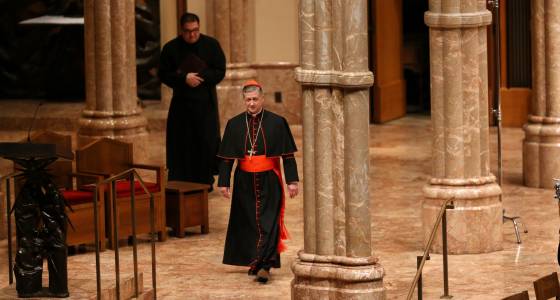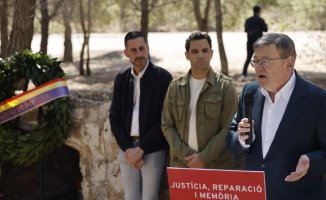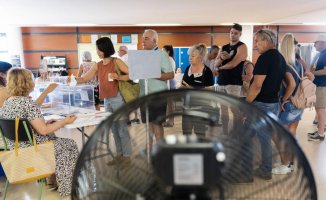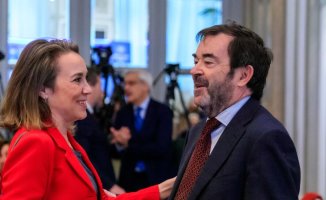Chicago Cardinal Blase Cupich told priests Tuesday that if federal immigration authorities knock on the doors of their parishes without a warrant, priests should turn them away and call the archdiocese's lawyers. Catholic school principals have been told to do the same.
"If they do not have a warrant and it is not a situation that someone is in imminent danger, tell them politely they cannot come on the premises," Cupich wrote in a letter to Chicago priests.
The directive comes a week after the Department of Homeland Security issued new guidelines for enforcing President Donald Trump's immigration orders that call for hiring thousands of additional enforcement agents and expanding the pool of immigrants who are targeted for removal. The new guidelines also authorize officers to conduct more raids in immigrant communities.
Gail Montenegro, a spokeswoman for Immigration and Customs Enforcement under the Department of Homeland Security, has said agents are still expected to abide by a 2011 directive in which federal agents were told to avoid "sensitive locations" — including hospitals, schools and houses of worship — unless there is an imminent risk.
"DHS is committed to ensuring that people seeking to participate in activities or utilize services provided at any sensitive location are free to do so without fear or hesitation," she said in a statement last month.
Still, new immigration priorities and expanded enforcement tactics under the new administration have struck fear in many communities, particularly among Latinos, who account for 44 percent of the diocese's 2.2 million Catholic faithful in Cook and Lake counties.
"With this letter I want to express my support as we stand together in solidarity with many of our parishioners who are deeply troubled by the recent executive orders related to immigration," Cupich wrote to the priests. "Their trust in you and the Church is prompting them to come to you for support, spiritual guidance and compassion. We need to stand together and clearly make it known that the Archdiocese of Chicago supports the dignity of all persons without regard to immigration status."
Trump sends mixed signals on immigration reform David Nakamura, Abby Phillip, Philip RuckerPresident Donald Trump offered mixed signals Tuesday about his plans on immigration, suggesting privately that he is open to an overhaul bill that could provide a pathway to legal status - but not citizenship - for potentially millions of people who are in the United States illegally but have not...
President Donald Trump offered mixed signals Tuesday about his plans on immigration, suggesting privately that he is open to an overhaul bill that could provide a pathway to legal status - but not citizenship - for potentially millions of people who are in the United States illegally but have not...
(David Nakamura, Abby Phillip, Philip Rucker)About two dozen houses of worship — synagogues, mosques and mostly Protestant churches — in the Chicago area are weighing whether to become sanctuaries to immigrants who are living in the U.S. illegally. The strategy reflects the resurgence of a political movement in the 1980s to shelter immigrants fleeing civil wars in El Salvador and Guatemala who were at risk of being sent back.
But the 2011 ICE memo distinguishing "sensitive locations" is not legally binding, and Cupich reiterated that sanctuary is not an acceptable strategy for Catholic parishes to adopt. Only ordained clergy and others assigned by the archbishop are permitted to live on church property, he said. Otherwise, the church risks offering false expectations of protection, he said.
"Moreover, immigration law does impose criminal penalties and fines for anyone who conceals, harbors or shields from detection, in any place, an alien who has come to, entered or remains in the United States in violation of the law," Cupich said.
International athletes at UIC worry about policies but prioritize team unity Shannon RyanOn election day in November, the Illinois-Chicago men's soccer team spent 4 1/2 hours on a bus to Dayton, Ohio, for the Horizon League championship.
The conversation was like many that day around the country and world.
"The topic was pretty (passionate)," said Oscar Rivero, a senior midfielder...
On election day in November, the Illinois-Chicago men's soccer team spent 4 1/2 hours on a bus to Dayton, Ohio, for the Horizon League championship.
The conversation was like many that day around the country and world.
"The topic was pretty (passionate)," said Oscar Rivero, a senior midfielder...
(Shannon Ryan)Instead, Cupich counseled priests who find immigration officials on their doorstep to ask for identification, the reason for the visit, and any documents they have, such as a warrant. If they present a warrant, priests should ask for time to review it and call archdiocese lawyers immediately. If they don't have a warrant, they should be asked to leave and archdiocese lawyers should be contacted.
Last week, Catholic school principals were instructed not to share student records with ICE agents without a court order and to turn away authorities who show up without a warrant. They also were told to update emergency contact information for families, a recommended measure in case parents and guardians are detained. Days earlier, Chicago Public Schools issued similar instructions to principals in its 650 schools.
But at the Catholic schools, one additional measure was recommended.
"For many of our immigrant families, the image of Our Lady evokes comfort and reverence," wrote Jim Rigg, superintendent of Catholic schools, in a letter to principals. "Placing such an image in your front office, hallway or other visible area can be a powerful sign of solidarity, particularly if this image connects culturally to the local immigrant community."
mbrachear@chicagotribune.com
Twitter @TribSeeker
Our editors found this article on this site using Google and regenerated it for our readers.












